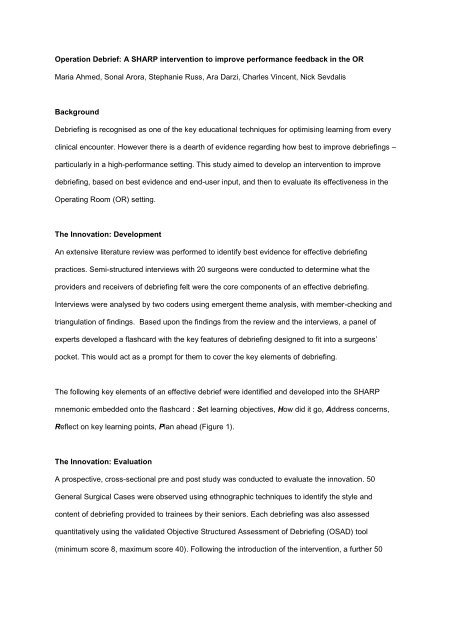Operation Debrief: A SHARP intervention to improve performance ...
Operation Debrief: A SHARP intervention to improve performance ... Operation Debrief: A SHARP intervention to improve performance ...
Operation Debrief: A SHARP intervention to improve performance feedback in the ORMaria Ahmed, Sonal Arora, Stephanie Russ, Ara Darzi, Charles Vincent, Nick SevdalisBackgroundDebriefing is recognised as one of the key educational techniques for optimising learning from everyclinical encounter. However there is a dearth of evidence regarding how best to improve debriefings –particularly in a high-performance setting. This study aimed to develop an intervention to improvedebriefing, based on best evidence and end-user input, and then to evaluate its effectiveness in theOperating Room (OR) setting.The Innovation: DevelopmentAn extensive literature review was performed to identify best evidence for effective debriefingpractices. Semi-structured interviews with 20 surgeons were conducted to determine what theproviders and receivers of debriefing felt were the core components of an effective debriefing.Interviews were analysed by two coders using emergent theme analysis, with member-checking andtriangulation of findings. Based upon the findings from the review and the interviews, a panel ofexperts developed a flashcard with the key features of debriefing designed to fit into a surgeons’pocket. This would act as a prompt for them to cover the key elements of debriefing.The following key elements of an effective debrief were identified and developed into the SHARPmnemonic embedded onto the flashcard : Set learning objectives, How did it go, Address concerns,Reflect on key learning points, Plan ahead (Figure 1).The Innovation: EvaluationA prospective, cross-sectional pre and post study was conducted to evaluate the innovation. 50General Surgical Cases were observed using ethnographic techniques to identify the style andcontent of debriefing provided to trainees by their seniors. Each debriefing was also assessedquantitatively using the validated Objective Structured Assessment of Debriefing (OSAD) tool(minimum score 8, maximum score 40). Following the introduction of the intervention, a further 50
<strong>Operation</strong> <strong>Debrief</strong>: A <strong>SHARP</strong> <strong>intervention</strong> <strong>to</strong> <strong>improve</strong> <strong>performance</strong> feedback in the ORMaria Ahmed, Sonal Arora, Stephanie Russ, Ara Darzi, Charles Vincent, Nick SevdalisBackground<strong>Debrief</strong>ing is recognised as one of the key educational techniques for optimising learning from everyclinical encounter. However there is a dearth of evidence regarding how best <strong>to</strong> <strong>improve</strong> debriefings –particularly in a high-<strong>performance</strong> setting. This study aimed <strong>to</strong> develop an <strong>intervention</strong> <strong>to</strong> <strong>improve</strong>debriefing, based on best evidence and end-user input, and then <strong>to</strong> evaluate its effectiveness in theOperating Room (OR) setting.The Innovation: DevelopmentAn extensive literature review was performed <strong>to</strong> identify best evidence for effective debriefingpractices. Semi-structured interviews with 20 surgeons were conducted <strong>to</strong> determine what theproviders and receivers of debriefing felt were the core components of an effective debriefing.Interviews were analysed by two coders using emergent theme analysis, with member-checking andtriangulation of findings. Based upon the findings from the review and the interviews, a panel ofexperts developed a flashcard with the key features of debriefing designed <strong>to</strong> fit in<strong>to</strong> a surgeons’pocket. This would act as a prompt for them <strong>to</strong> cover the key elements of debriefing.The following key elements of an effective debrief were identified and developed in<strong>to</strong> the <strong>SHARP</strong>mnemonic embedded on<strong>to</strong> the flashcard : Set learning objectives, How did it go, Address concerns,Reflect on key learning points, Plan ahead (Figure 1).The Innovation: EvaluationA prospective, cross-sectional pre and post study was conducted <strong>to</strong> evaluate the innovation. 50General Surgical Cases were observed using ethnographic techniques <strong>to</strong> identify the style andcontent of debriefing provided <strong>to</strong> trainees by their seniors. Each debriefing was also assessedquantitatively using the validated Objective Structured Assessment of <strong>Debrief</strong>ing (OSAD) <strong>to</strong>ol(minimum score 8, maximum score 40). Following the introduction of the <strong>intervention</strong>, a further 50
General Surgical cases debriefings were observed and assessed using the same measures. 20% ofcases were observed by a second researcher <strong>to</strong> test inter-rater reliability.Inter-rater reliability for OSAD was excellent (ICC = 0.994). Quality of debriefings as assessed byOSAD significantly <strong>improve</strong>d following the <strong>intervention</strong> (Pre Median = 19, Range 8-31; Post Median =33, Range 26-40, p



